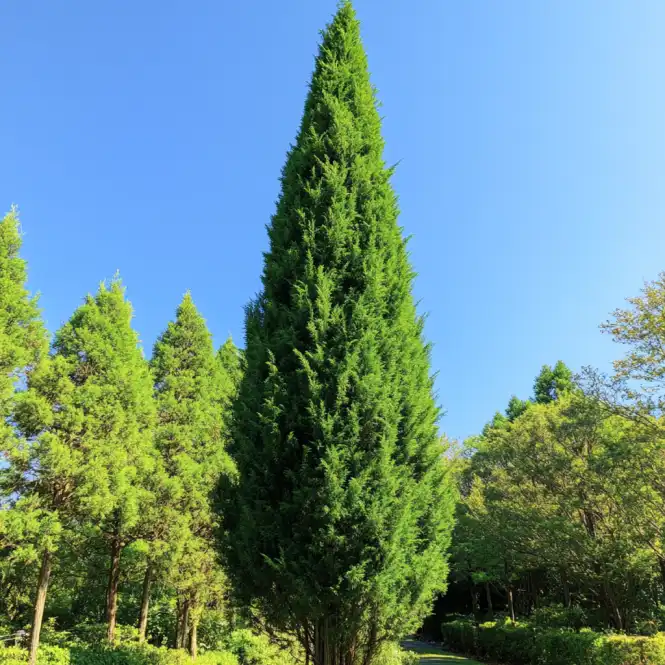If you’re searching for a natural, eco-friendly way to shield your yard from prying eyes, privacy trees are one of the best landscaping solutions available. Not only do these living barriers provide year-round greenery and seclusion, but they also help create a shaded, peaceful outdoor space that feels like your own private oasis. Whether you’re looking to reduce traffic noise, hide unsightly views, or add structure to your yard, the right privacy trees can truly transform your landscape.
In this comprehensive guide, we’ll highlight 11 of the best privacy trees for your yard, whether you’re working with a tight urban space or a wide-open garden. From tall hedging evergreens to narrow varieties like Sky Pencil Holly, there’s a tree for every climate and yard size. You’ll also find expert tips for creating a layered, long-lasting privacy screen and maintaining healthy growth.
So if you’re ready to replace fences with foliage and boost your backyard’s beauty and function, read on to discover the perfect privacy trees to plant today.
Table of Contents
1. Eastern Redcedar
Best for: Large backyards needing dense, year-round privacy
The Eastern Redcedar is a rugged evergreen that’s as tough as it is attractive. With its thick, aromatic foliage and reddish bark, this native tree creates a solid, natural barrier that offers full privacy in nearly any season. Birds love its berries, making it a wildlife-friendly option as well.
🌲 Key Features:
- Height: 40–60 feet
- Width: 10–20 feet
- USDA Zones: 3–9
- Sunlight Needs: Full to partial sun (4–8 hours daily)
🌿 Why It’s a Great Privacy Tree:
- Thick coverage: Its dense branches form a natural wall
- Low-maintenance: Drought- and cold-tolerant once established
- Attracts wildlife: Provides shelter and food for birds
- Long lifespan: A slow grower but worth the wait for lasting privacy
🌱 Planting Tips:
Eastern Redcedars are ideal for large spaces—give them at least 15–20 feet between trunks. Avoid planting near homes or power lines, as they’ll reach impressive heights and widths over time. Once established, they can handle tough conditions, from harsh winters to dry summers, with ease.
🌟 Pro Tip: Pair with other evergreen trees like Spartan Junipers for layered visual interest and faster screening while Redcedars mature.
2. Weeping White Spruce
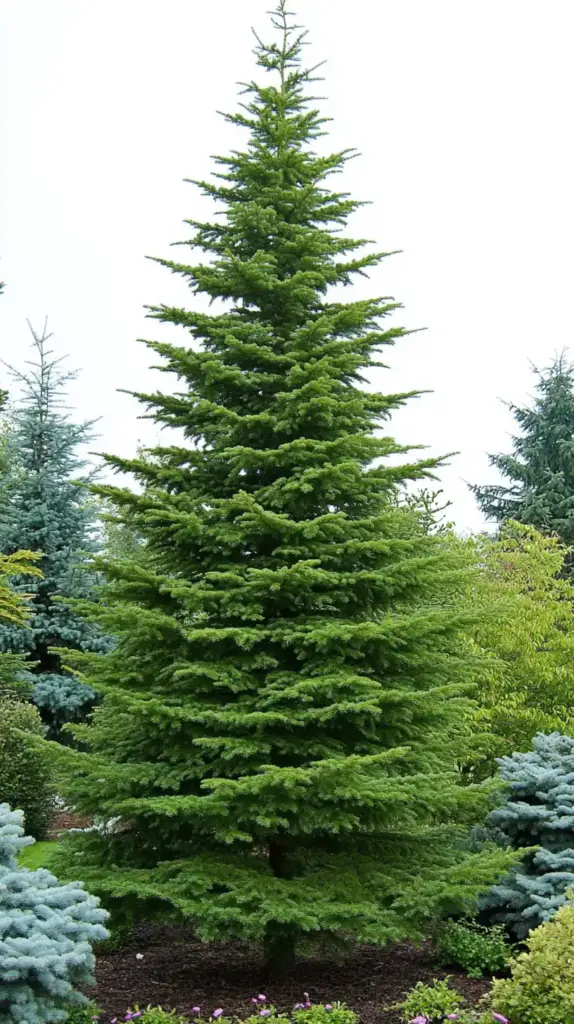
Best for: Narrow spaces needing vertical privacy with style
If you’re looking for a privacy tree that adds grace as well as coverage, the Weeping White Spruce fits the bill. Its draping blue-green branches create a soft, flowing curtain of foliage that offers year-round screening without taking up much horizontal space.
🌲 Key Features:
- Height: 30–50 feet
- Width: 6–10 feet
- USDA Zones: 2–9
- Sunlight Needs: Full sun to partial shade
🌿 Why It’s a Great Privacy Tree:
- Vertical structure: Perfect for narrow lots or tight property lines
- Drought-tolerant: Once established, it needs minimal watering
- Cold-hardy: Withstands severe winters down to -50°F
- Elegant look: Adds ornamental value and softens harsh lines in the landscape
🌱 Planting Tips:
Weeping White Spruce trees thrive in well-drained soil and perform best with full sun. Space them about 10 feet apart if planting in a row. Their slender shape makes them ideal for framing entryways, lining fences, or offering privacy between close neighbors without sacrificing aesthetics.
🌟 Pro Tip: Combine these with wider evergreens like Green Giant Thujas to create a visually layered privacy screen that’s both stylish and functional.
3. Leyland Cypress
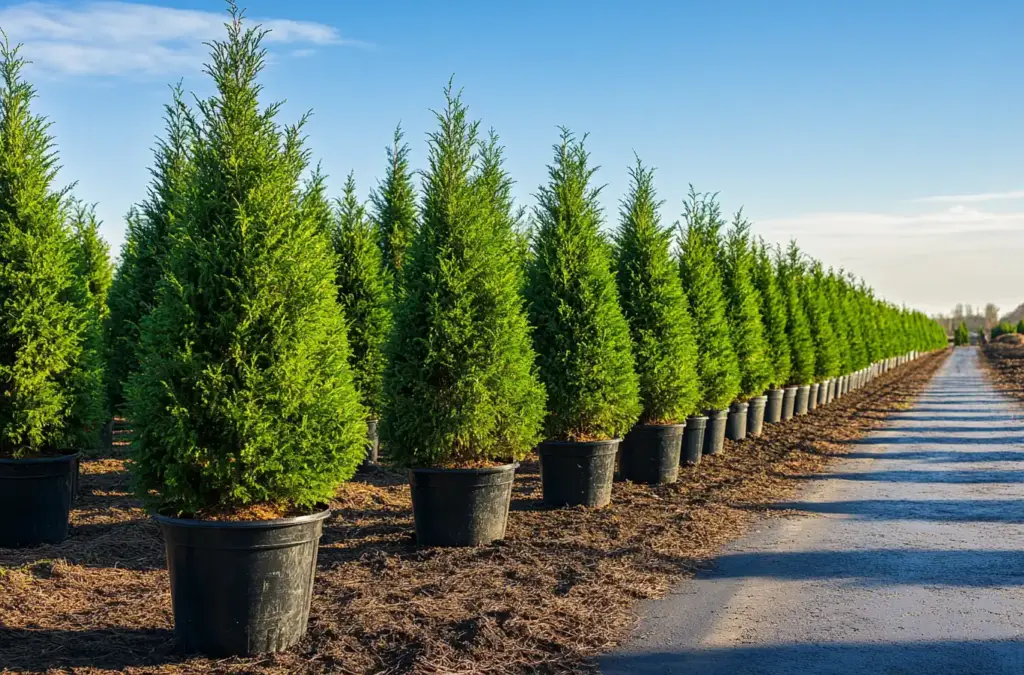
Best for: Rapid privacy in large, sunny yards
When time is of the essence and you need a green wall fast, Leyland Cypress is a top contender. This vigorous evergreen is beloved for its rapid growth and lush, dense foliage, making it ideal for creating tall hedges or windbreaks in just a few years.
🌲 Key Features:
- Height: 40–70 feet
- Width: 15–30 feet
- USDA Zones: 6–10
- Sunlight Needs: Full sun (6+ hours daily)
🌿 Why It’s a Great Privacy Tree:
- Fast-growing: Can grow up to 3 feet per year
- Dense foliage: Offers complete visual and sound screening
- Low-maintenance: Tolerates drought, salt, and urban pollution
- Versatile: Works well for property lines, borders, and wind protection
🌱 Planting Tips:
To form a dense screen, space Leyland Cypress trees 6 to 10 feet apart. Their shallow root systems mean they prefer well-drained soil, and they’re not ideal for areas with very hot summers or heavy clay soil. Prune them annually to maintain shape and prevent overgrowth.
🌟 Pro Tip: If you’re in a coastal area, Leyland Cypress is a smart pick thanks to its salt tolerance and adaptability to sandy soils.
4. Spartan Juniper
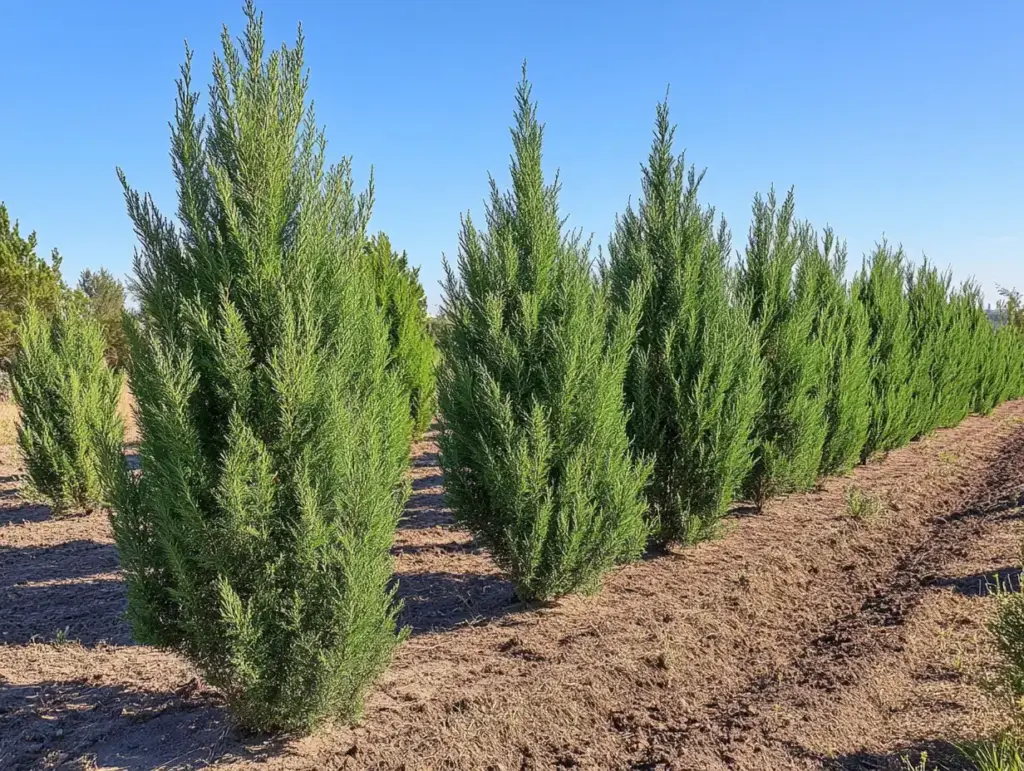
Best for: Narrow yards and modern, uniform hedging
If your yard is short on space but big on privacy goals, the Spartan Juniper is a smart and stylish choice. This columnar evergreen has a tidy, uniform appearance and dense green foliage, making it ideal for hedging, windbreaks, or framing around patios.
🌲 Key Features:
- Height: Up to 15 feet
- Width: 3–5 feet
- USDA Zones: 5–9
- Sunlight Needs: Full sun (6+ hours daily)
🌿 Why It’s a Great Privacy Tree:
- Space-saving: Slim, vertical growth perfect for tight spaces
- Low-maintenance: Drought-resistant and adapts well to poor soils
- All-season screening: Keeps its rich green color year-round
- Contemporary look: Ideal for modern landscapes or minimalist garden design
🌱 Planting Tips:
Spartan Junipers prefer dry, well-drained soil and should be spaced about 4–5 feet apart for a continuous hedge. Avoid overwatering to prevent root rot, and prune sparingly, as they maintain their shape well naturally.
🌟 Pro Tip: For a clean and formal look, plant these in a row along fences or property lines. Their upright shape offers privacy without overwhelming your space.
5. Sky Pencil Holly
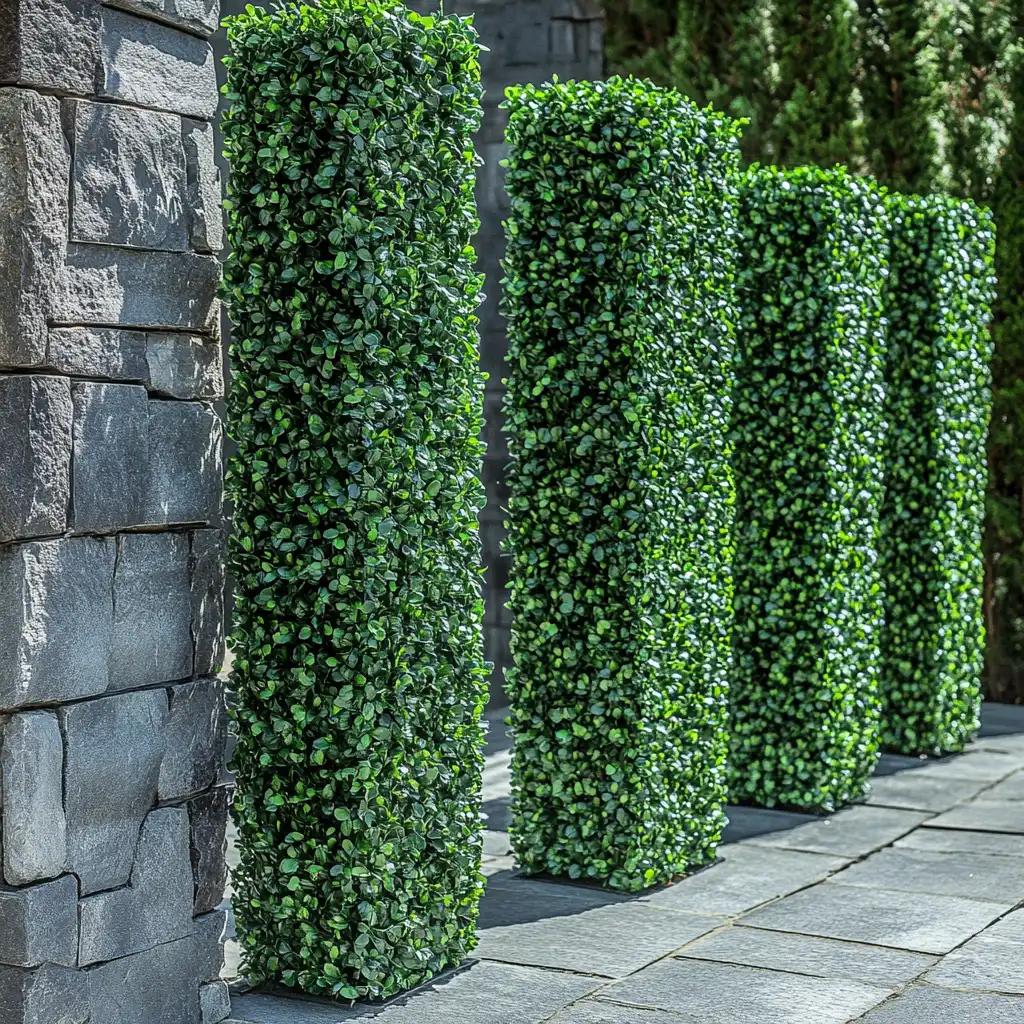
Best for: Small spaces, patios, and container privacy
Don’t have much room to work with? The Sky Pencil Holly is a sleek and slender evergreen that delivers vertical privacy without hogging precious square footage. Its name says it all — this upright holly grows like a pencil, offering privacy in the narrowest of spaces, including urban patios, balconies, and small garden beds.
🌲 Key Features:
- Height: 8–10 feet
- Width: ~2 feet
- USDA Zones: 5–9
- Sunlight Needs: Full to partial sun (3–6+ hours daily)
🌿 Why It’s a Great Privacy Tree:
- Ultra-slim profile: Ideal for lining walkways or compact gardens
- Soft texture: Unlike traditional hollies, its leaves aren’t spiky
- Container-friendly: Perfect for decks, rooftops, or apartment gardens
- Low-fuss care: Adapts to various soils and climates
🌱 Planting Tips:
Plant Sky Pencil Holly about 2 feet apart for a tight, upright screen. They do well both in the ground and in pots — just ensure proper drainage to prevent soggy roots. Though evergreen, they benefit from a layer of mulch to help retain soil moisture and regulate temperature.
🌟 Pro Tip: Use Sky Pencil Holly in a decorative container row to add vertical structure and privacy to patios or outdoor dining areas.
6. Green Giant Thuja (Arborvitae)

Best for: Quick, low-maintenance privacy in diverse climates
The Green Giant Thuja, also known as Thuja standishii × plicata, is a go-to tree for homeowners who want tall, lush privacy fast — without the fuss. This hybrid arborvitae is celebrated for its fast growth, pest resistance, and beautiful conical shape that stays full from base to tip.
🌲 Key Features:
- Height: 30–40 feet
- Width: 5–8 feet
- USDA Zones: 5–9
- Sunlight Needs: Full to partial sun (3–6+ hours daily)
🌿 Why It’s a Great Privacy Tree:
- Fast-growing: Gains 3–5 feet per year under ideal conditions
- Evergreen density: Thick foliage creates an immediate green wall
- Deer-tolerant: More resistant than other arborvitae varieties
- Adaptable: Tolerates heat, humidity, cold, and drought
🌱 Planting Tips:
Plant Green Giants 5–8 feet apart for optimal screening. Choose a well-drained site with good air circulation. Though highly adaptable, avoid low-lying or soggy areas to prevent root issues. Once established, they require very little maintenance and look great with minimal pruning.
🌟 Pro Tip: For a formal look, lightly trim the tops each year. For a more rustic, natural hedge, let them grow freely.
7. Emerald Green Thuja (Arborvitae)
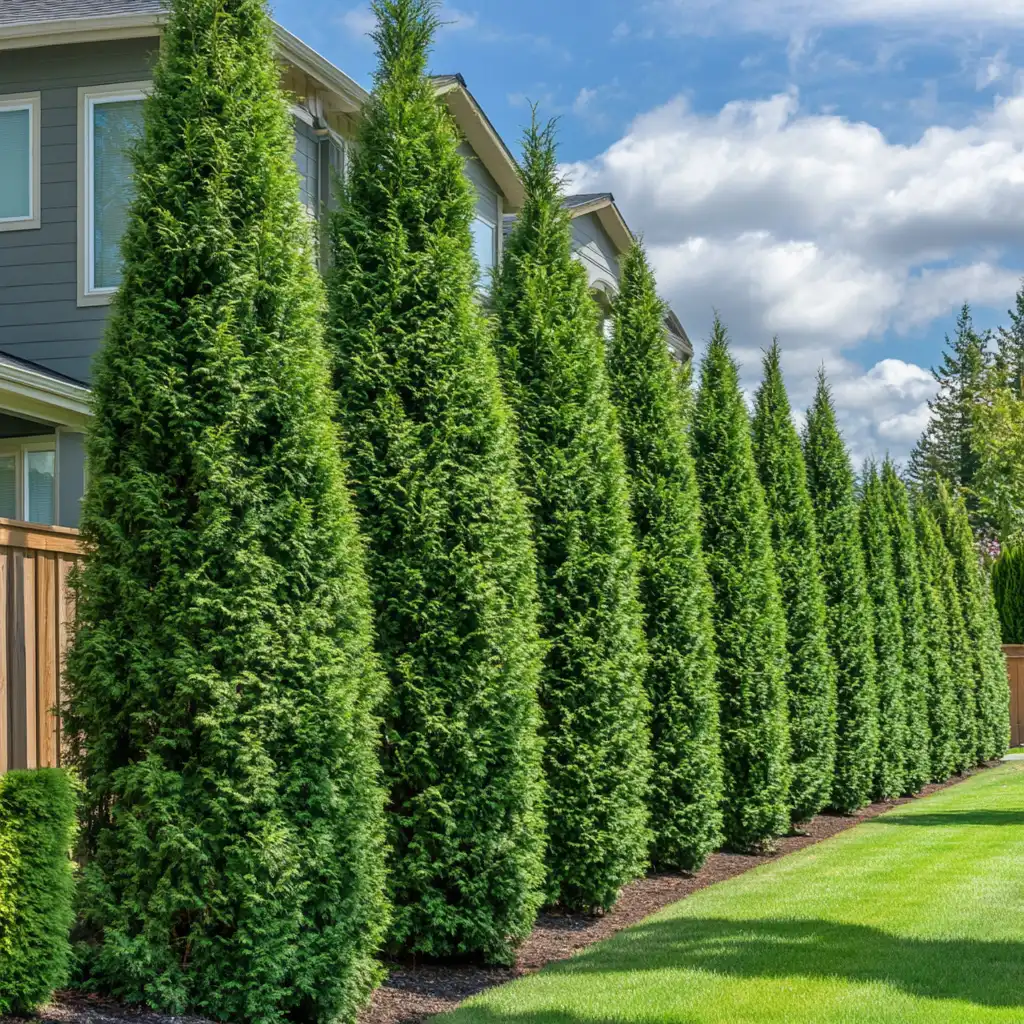
Best for: Smaller yards and formal hedges
The Emerald Green Thuja, also known as Thuja occidentalis ‘Smaragd’, is the perfect privacy tree for medium-sized landscapes. Its rich emerald foliage, narrow shape, and predictable growth make it a favorite for tidy, uniform hedging along fences, property lines, and patios.
🌲 Key Features:
- Height: 12–14 feet
- Width: 3–4 feet
- USDA Zones: 3–8
- Sunlight Needs: Full to partial sun (3–6+ hours daily)
🌿 Why It’s a Great Privacy Tree:
- Space-efficient: Slim profile fits well in tighter yards
- Consistent growth: Grows 6–9 inches per year for predictable shaping
- Evergreen screen: Maintains color and form throughout all seasons
- Cold-hardy: Withstands snow, ice, and freezing temperatures
🌱 Planting Tips:
Space Emerald Green Thuja trees about 2–3 feet apart for a dense, seamless screen. They prefer moist, well-drained soil and benefit from mulching around the base to retain moisture and protect roots. These trees require little pruning, but occasional shaping can enhance their neat appearance.
🌟 Pro Tip: Use Emerald Green Thujas as a natural fence replacement, especially in neighborhoods with size restrictions on trees or shrubs.
8. Flowering Dogwood
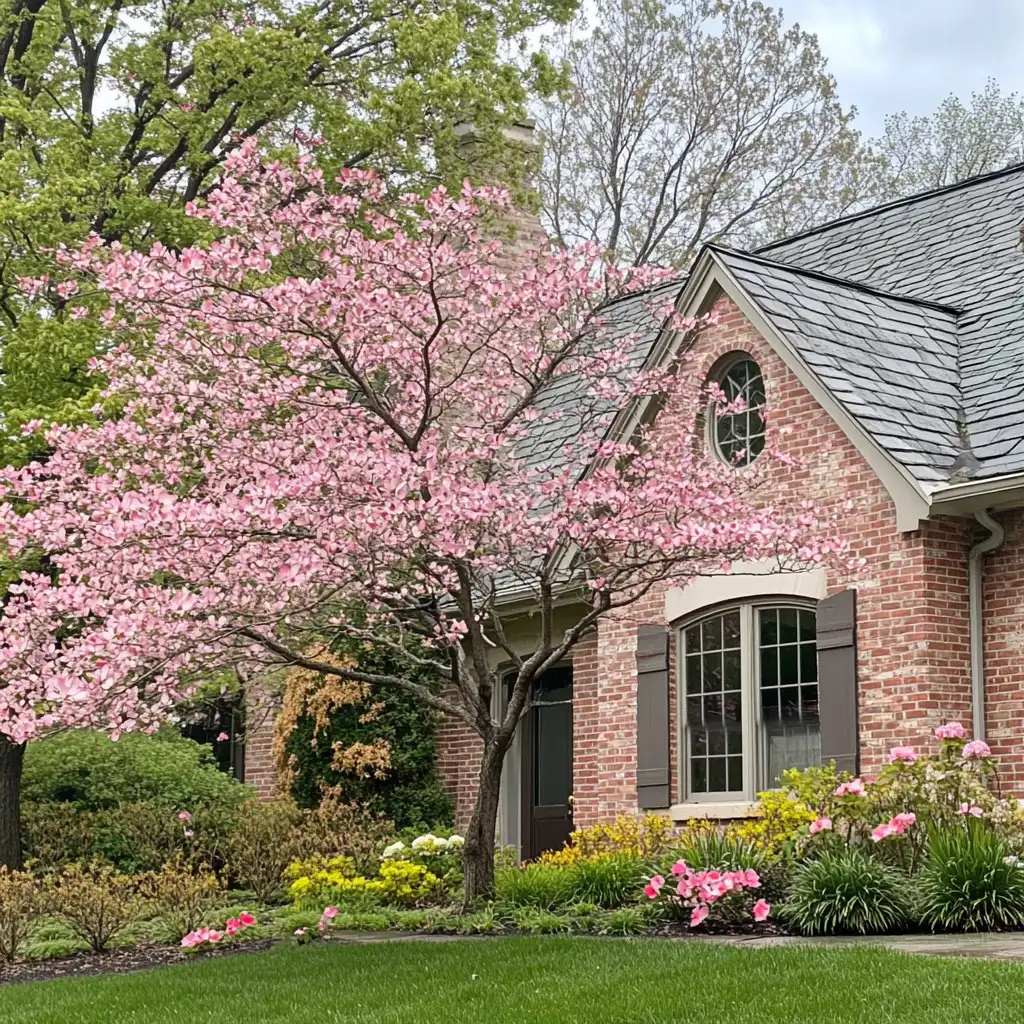
Best for: Seasonal privacy with added beauty and wildlife appeal
Looking for privacy with a splash of seasonal color? The Flowering Dogwood offers lovely spring blooms, rich fall foliage, and red berries that attract songbirds. While not evergreen, this small tree works beautifully as a decorative screen or a complement to taller privacy trees.
🌲 Key Features:
- Height & Width: 15–25 feet
- USDA Zones: 5–8
- Sunlight Needs: Full sun to partial shade (3–6+ hours daily)
🌿 Why It’s a Great Privacy Tree:
- Spring blossoms: White, pink, or red flowers add visual interest
- Wildlife magnet: Berries attract birds and pollinators
- Multi-season appeal: Vibrant fall color and textured bark in winter
- Compact size: Fits well in smaller landscapes and around patios
🌱 Planting Tips:
Dogwoods thrive in well-drained, slightly acidic soil with morning sun and afternoon shade. Space them about 15–20 feet apart when using them for partial privacy. For maximum effect, place them in front of taller evergreens to create a layered, natural barrier.
🌟 Pro Tip: Plant Dogwoods near windows or outdoor seating areas to enjoy their seasonal beauty up close — they’re excellent focal points as well as privacy enhancers.
9. Weeping Podocarpus
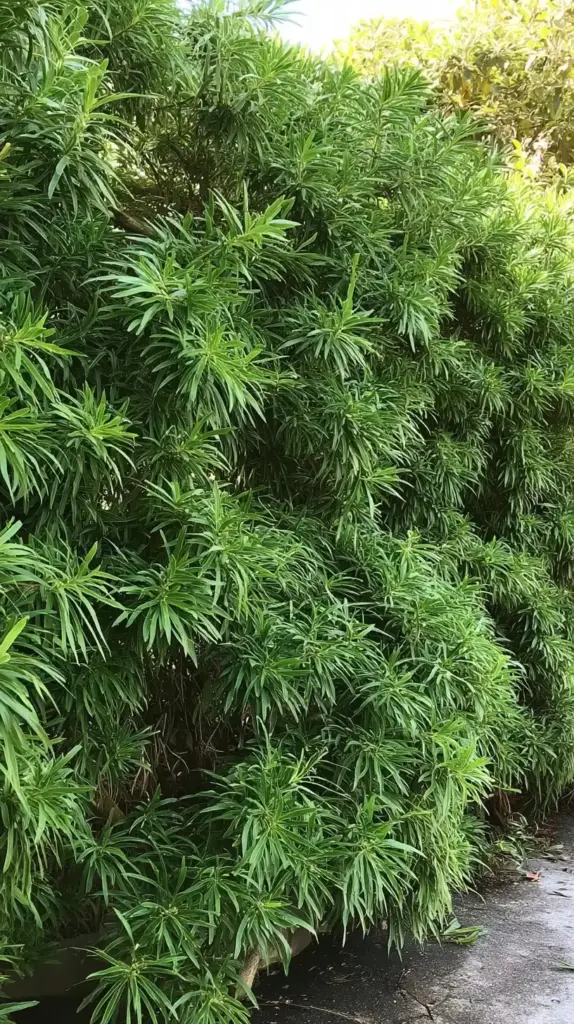
Best for: Southern/coastal landscapes and soft-textured privacy
With its graceful, flowing foliage and vertical growth habit, the Weeping Podocarpus (sometimes called “Buddhist Pine”) adds an elegant and tropical feel to privacy plantings. This evergreen is especially suited to southern states and coastal regions, where it thrives in warm, humid conditions.
🌲 Key Features:
- Height: 35–45 feet
- Width: 10–20 feet
- USDA Zones: 9–11
- Sunlight Needs: Full to partial sun (3–6+ hours daily)
🌿 Why It’s a Great Privacy Tree:
- Soft texture: Lush, drooping foliage adds visual softness
- Fast-growing: Can provide privacy quickly in warm climates
- Salt-tolerant: Excellent for coastal properties
- Minimal mess: Doesn’t produce messy fruit or excessive litter
🌱 Planting Tips:
Weeping Podocarpus should be spaced about 5–10 feet apart when creating a privacy hedge. These trees prefer dry, well-drained soil and benefit from occasional deep watering during dry spells. Because of their graceful shape, they require little to no pruning to look polished.
🌟 Pro Tip: Combine Weeping Podocarpus with shorter, flowering plants at the base for a lush, layered tropical garden that doubles as a living privacy wall.
10. Goldspire Ginkgo
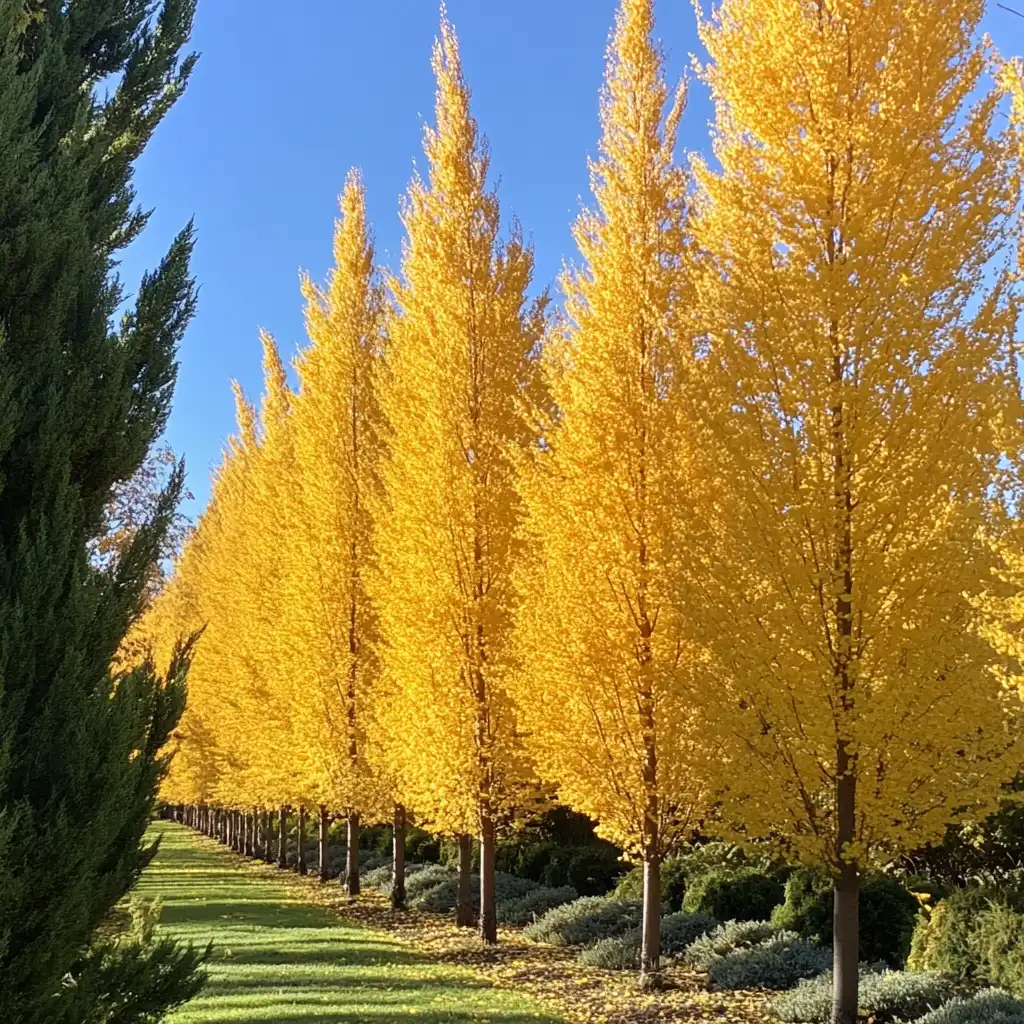
Best for: Narrow spaces and bold fall color
The Goldspire Ginkgo combines the ancient resilience of the Ginkgo tree with a compact, columnar form that makes it ideal for modern privacy screens. Unlike traditional ginkgoes, this non-fruiting cultivar won’t drop messy berries — just golden foliage in autumn that lights up the landscape.
🌲 Key Features:
- Height: 14–16 feet
- Width: 5–6 feet
- USDA Zones: 4–9
- Sunlight Needs: Full to partial sun (3–6+ hours daily)
🌿 Why It’s a Great Privacy Tree:
- Narrow form: Perfect for tight side yards, driveways, or walkways
- Spectacular fall color: Deep green leaves turn brilliant yellow
- Low-maintenance: Pest-resistant, pollution-tolerant, and hardy
- Non-fruiting: No odor or mess like traditional female ginkgo trees
🌱 Planting Tips:
Goldspire Ginkgo trees prefer full sun and well-drained soil. Space them about 6–8 feet apart to form a loose privacy line. Their upright growth means they rarely need pruning, but removing lower branches can emphasize their vertical shape if desired.
🌟 Pro Tip: Use Goldspire Ginkgo as a living accent wall behind garden beds or along entry paths. Their upright form and golden foliage add drama with function.
11. Hybrid Willow Tree (Fastest Growing)
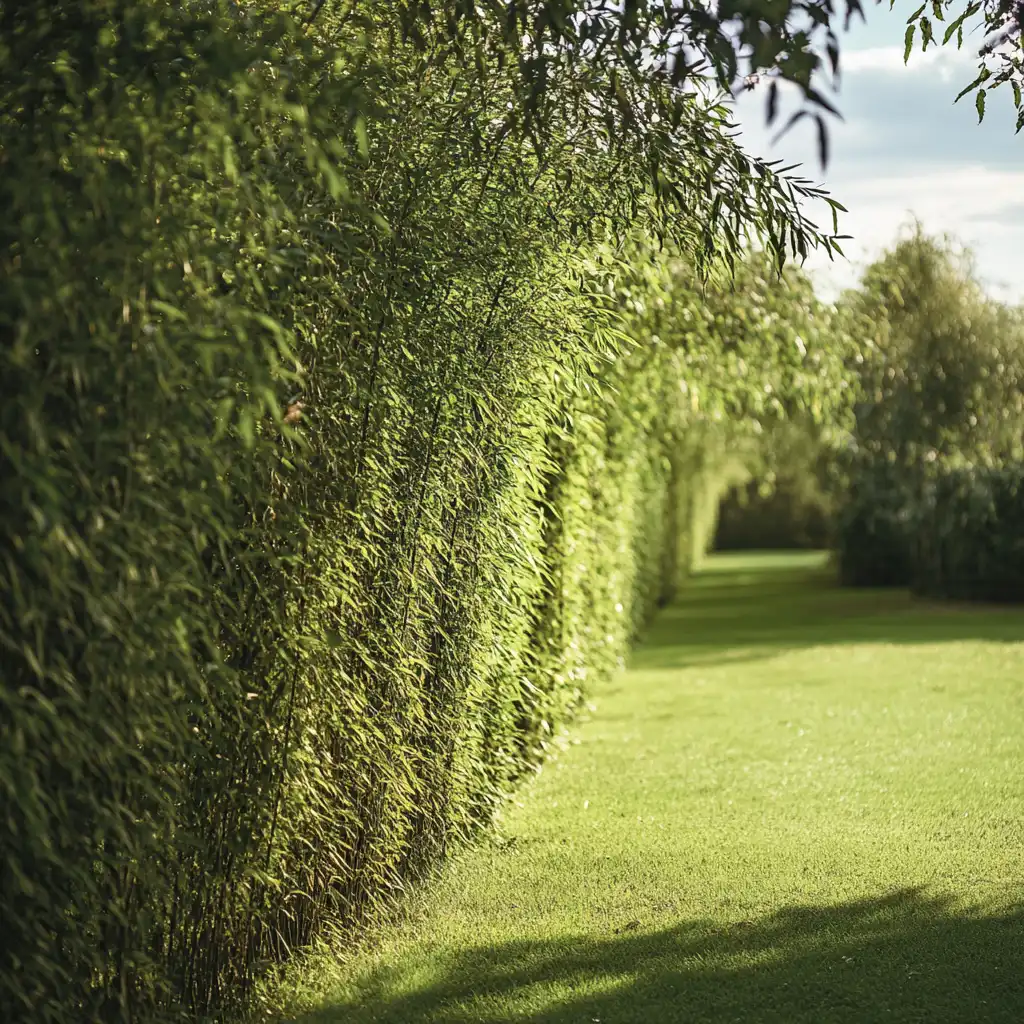
Best for: Quick privacy, windbreaks, and large yards
When you need privacy yesterday, the Hybrid Willow Tree is your answer. With a jaw-dropping growth rate of 6 to 10 feet per year, this tree can reach towering heights in just a few seasons. It forms a dense, green wall that’s ideal for large backyards, rural properties, or areas that need quick coverage from wind and noise.
🌲 Key Features:
- Height: 35–75 feet (depending on spacing)
- Width: ~20 feet
- USDA Zones: 4–9
- Sunlight Needs: Full to partial sun (3–6+ hours daily)
🌿 Why It’s a Great Privacy Tree:
- Fastest grower: Ideal for quick coverage
- Thick foliage: Blocks out views, noise, and wind
- Hardy and versatile: Adapts to many climates and soil conditions
- Eco-friendly: Can help dry out wet or swampy areas
🌱 Planting Tips:
Hybrid Willows thrive in moist soil and sunny locations. To form a privacy barrier, plant them 5 feet apart in a row. Though they tolerate some drought once established, regular watering in the first year ensures healthy growth. Watch for invasive roots near foundations or pipes — give them space!
🌟 Pro Tip: Use Hybrid Willows as a fast filler while slower-growing trees mature. Later, they can be thinned or pruned to maintain balance in your privacy landscape.
🌱 Additional Tips for Choosing and Planting Privacy Trees
Planting a living privacy wall is more than just digging a few holes — it’s about making thoughtful decisions that suit your landscape and long-term goals. Here are a few expert-backed tips to help you get the most from your investment in privacy trees:
✅ 1. Know Your Growing Zone
Before selecting a tree, make sure it’s suitable for your USDA Hardiness Zone. This helps ensure it will survive winter lows and thrive in your region’s climate. Not sure which zone you’re in? Use the USDA Zone Finder.
✅ 2. Consider Mature Size
A cute 3-foot tree may look manageable now, but some species can hit 60+ feet at maturity. Always research how tall and wide your selected tree will get and give it enough room to grow without crowding structures, sidewalks, or power lines.
✅ 3. Mix and Match for Best Results
Combining fast-growers like Hybrid Willows with slower, longer-lasting trees like Eastern Redcedars can give you both immediate and long-term privacy. Mixing species also adds visual interest and reduces the risk of pest or disease wipeout.
✅ 4. Plan for Maintenance
Some trees need occasional trimming (like Leyland Cypress), while others are virtually self-sustaining (like Spartan Juniper). Think about how much time and energy you want to devote to upkeep before choosing.
✅ 5. Consult a Local Expert
Your local nursery or extension office can offer personalized advice based on soil type, rainfall patterns, pests, and sun exposure in your exact location. Bringing a photo of your yard and rough measurements will help them make the best recommendations.
🌟 Pro Tip: Privacy trees aren’t just functional — they can elevate the entire look and feel of your backyard when planned with care.
❓ Frequently Asked Questions About Privacy Trees
🌲 What are the best fast-growing privacy trees?
When time is of the essence, fast-growing privacy trees like Hybrid Willow and Leyland Cypress are your best bet. These trees can grow between 3 to 10 feet per year, quickly forming a lush, green wall that offers immediate privacy and noise protection.
🌳 Which privacy trees are best for small yards?
In smaller spaces, opt for slim-growing privacy trees like Sky Pencil Holly, Emerald Green Thuja, or Spartan Juniper. Their compact footprints make them ideal for patios, walkways, or tight garden corners without compromising on greenery.
🏡 Do privacy trees lose their leaves in winter?
Some do. Evergreen privacy trees like Green Giant Thuja and Weeping White Spruce keep their foliage year-round. Deciduous options like Flowering Dogwood drop their leaves in fall but offer vibrant blooms and seasonal charm during spring and summer.
💧 How often should I water newly planted privacy trees?
In their first year, water privacy trees deeply once or twice per week, especially in dry spells. After establishing roots, drought-tolerant varieties such as Spartan Juniper and Podocarpus require minimal maintenance — making them ideal for low-water landscaping and eco-friendly gardens.
🌡️ What trees provide privacy in cold climates?
Cold-hardy privacy trees like Weeping White Spruce, Emerald Green Thuja, and Eastern Redcedar can handle snow and freezing temperatures. Check out our guide on privacy landscaping in tough climates for year-round screening solutions that won’t wilt in winter.
🦌 Are privacy trees deer-resistant?
While no tree is completely deer-proof, deer-tolerant privacy trees like Green Giant Thuja and Spartan Juniper offer strong resistance. In areas with heavy deer activity, consider adding fencing or using natural repellents, especially during the early years of growth.
🪴 Can I grow privacy trees in containers?
Absolutely! Compact privacy trees such as Sky Pencil Holly and Emerald Green Thuja are perfect for container gardening on patios, balconies, or urban rooftops. For design ideas, visit our small garden layout guides.
🌿 Conclusion: Creating Privacy with Purpose
Whether you’re trying to block your neighbor’s view, cut down on street noise, or simply craft a peaceful backyard sanctuary, privacy trees offer a natural, stunning, and long-term solution. Unlike fences that can wear down or clash with your landscape, privacy trees like Leyland Cypress and Emerald Green Thuja grow more beautiful each year — and they do double duty by adding shade and wildlife habitat.
From towering giants to narrow growers like Sky Pencil Holly, there’s a privacy tree perfect for every yard size, climate, and design style. If you’re planting near a fence or property line, check out our guide to fast-growing privacy trees along a fence for quick coverage options.
Evaluate your space, maintenance goals, and landscaping needs around trees before planting. With the right mix, you can grow a lush, layered screen that adds long-lasting beauty and privacy to your yard.
Remember: good fences may make good neighbors — but great privacy trees make even better ones.


